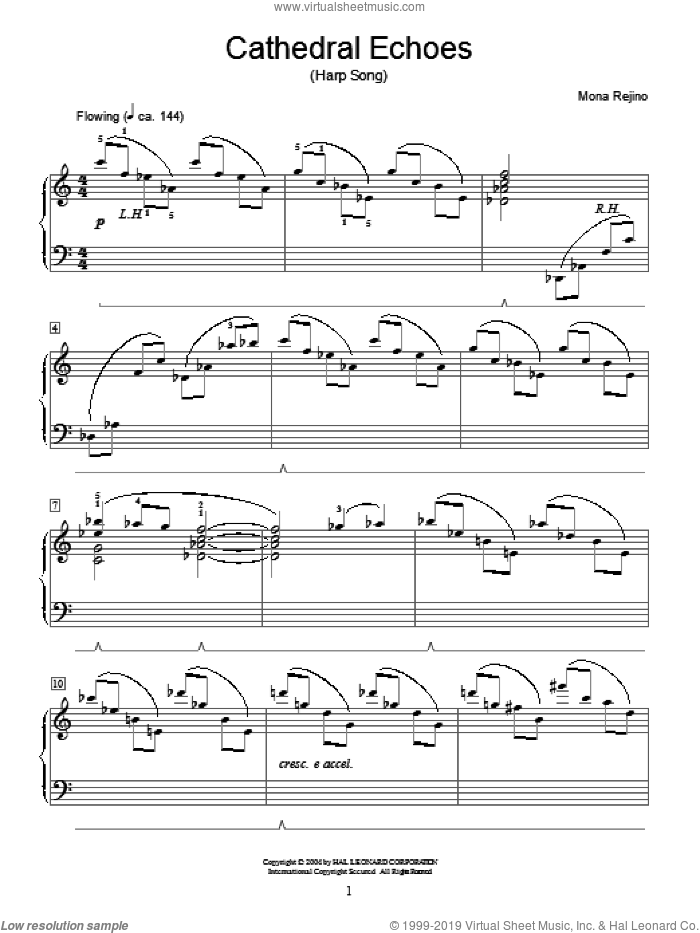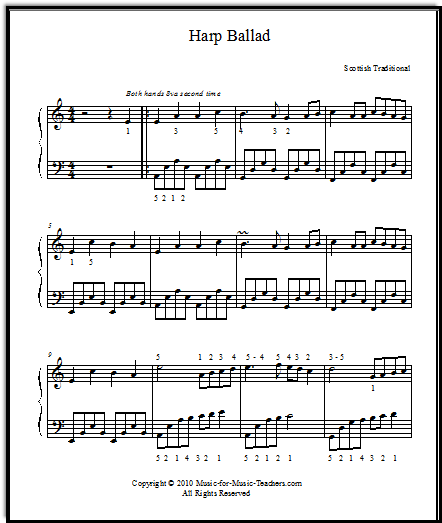Piano sheet music can be used for harp, but adaptations may be necessary. Harpists often rearrange music to fit their instrument’s range and playing techniques.
The process of adapting piano sheet music for the harp requires a blend of creativity and musical expertise. While many piano scores lend themselves to the harp’s sonorous capabilities, the inherent differences between the two instruments call for thoughtful adjustments.
As a stringed instrument, the harp’s playing mechanics differ from the piano’s percussive action, leading players to modify sheet music to better align with the harp’s glissandos and pedal changes. This practice opens a vast repertoire of classical and modern pieces to harpists, encouraging a fluid musical exchange between pianos and harps. With such adaptations, the eloquent resonance of the harp breathes new life into compositions originally crafted for piano keys.

Credit: www.virtualsheetmusic.com
The Interchangeability Of Musical Scores
Exploring the world of music, artists often ask if they can use piano sheet music for the harp. This sparks an intriguing conversation about score interchangeability. Let’s dive into the fascinating aspects of musical notation and how they apply to different instruments.
Similarities In Musical Notation
Musical scores serve as a universal language for musicians. This is why piano sheet music often becomes a starting point for harpists. Both instruments share standard notation, which includes:
- Staff lines
- Notes and note values
- Rests
- Clefs
- Key and time signatures
The similarity in these elements means harpists can read piano music and understand the fundamental melodies and rhythms.
Instrumental Range Considerations
When adapting piano scores for the harp, one should consider the range of the instrument. The piano has a wider range than the typical harp. Piano music spans up to 88 keys, while a pedal harp typically has 47 strings. Harpists must often transpose or alter pieces to fit the instrument’s range. Here’s a comparison:
| Instrument | Range |
|---|---|
| Piano | 88 keys (A0-C8) |
| Harp | 47 strings (C1-G7) |
Understanding these differences helps musicians make informed choices when using piano sheet music for the harp.

Credit: musescore.com
Adapting Piano Music For Harp
Aspiring harpists often wonder if they can bring the melodies of the piano into their realm. Adapting piano music for harp is not just possible; it’s a doorway to an even richer world of musical exploration. By understanding a few key adjustments, piano scores can transform into beautiful harp performances.
Transposing Piano Keys To Harp Pedals
One of the first steps in adapting piano music is understanding the harp’s pedaling system. Unlike the piano, the harp uses pedals to change pitch. These need to match the piano’s keys. Many times, notes must be repositioned to align with available pedals.
- Identify the key signature of the piano piece.
- Match each piano key to its corresponding pedal setting.
- Modify any chromatic alterations with enharmonic equivalents.
Arrangement Adjustments
Harp-specific limitations mean that some piano arrangements won’t transfer directly. Chords may need to be revoiced to accommodate the harp’s string layout. Here, creativity blossoms as you redefine what’s essential in the piece.
- Break down complex chords into playable arpeggios.
- Highlight the melody, often simplifying the accompaniment.
- Consider the resonant nature of the harp when choosing sustained notes.
Overcoming Octave Spans
The piano’s expansive range can result in octave spans that are too wide for the harp. It’s crucial to condense the octaves without losing the piece’s essence. This might include:
- Shifting notes within the harp’s range.
- Choosing alternate octaves for certain passages.
- Preserving the core melody and bass when possible.
Technical Challenges In Conversion
Translating piano sheet music into harp arrangements brings unique technical challenges. Both instruments weave harmonies and melodies in distinctly different ways. This means direct conversions aren’t always straightforward. Let’s dive into the specifics of these challenges.
Pedal Changes And Limitations
The harp has pedals that alter the pitch of the strings, unlike the piano’s keys that play individual notes. There are seven pedals on a pedal harp, each corresponding to a musical note. This setup limits how quickly you can change keys or play accidentals.
When converting piano music to harp:
- Pianists may shift keys rapidly, but harpists need more time for pedal adjustments.
- Complex key signatures famous in piano pieces can pose a significant challenge on the harp, demanding skillful pedal changes.
- Some piano pieces with frequent accidentals are nearly impossible to play on the harp without simplification.
Chord Voicings And Hand Positioning
Piano chords often span more than an octave, but harp chords are limited to the natural hand span of the harpist. This restriction means you might need to rearrange or even omit some notes when converting piano sheets for harp use. Additionally, pianists can easily play with both hands on different parts of the keyboard, but harpists often can’t replicate this division of labor across their instrument.
Key elements to consider:
- Chords may require revoicing to fit into a single hand span on the harp.
- Dense piano textures might get thinned out to remain playable on the harp.
- Harmonic changes need rethinking to respect the harp’s unique resonance and sustain.
Historical Context Of Instrument-specific Scores
The journey of musical notation is rich in history, shaping how music translates across various instruments. Initially, scores were rudimentary, serving as simple guidelines for musicians. As music evolved, so did the complexity and specificity of these scores.
Evolution Of Sheet Music
Sheet music has transformed dramatically since its inception. In the early days, it was merely a collection of lines and neumes – symbols that indicated melodic direction. These scores were not instrument-specific. This changed as music composition and performance grew more sophisticated.
- The Middle Ages introduced precise rhythmic notation.
- Renaissance era brought in measured music notation.
- Baroque period saw the rise of instrument-specific scores.
By the Classical period, piano scores became highly structured, demanding techniques unique to keyboard instruments. Likewise, the harp saw tailored compositions that leveraged its string resonance and pedaling system.
Comparative Study Of Harp And Piano Pieces
Piano and harp music bear similarities but also exhibit clear differences. Both instruments use the grand staff, combining treble and bass clefs. This makes piano sheet music appear compatible with the harp at a cursory glance.
| Piano | Harp |
|---|---|
| Hammer action to strike keys | Plucking of strings |
| Multiple notes with one hand | Limited to one note per finger |
| Pedals alter tone color | Pedals change pitch |
Adapting piano music for the harp involves more than a straight conversion. Pianists can sustain notes with pedals, something harpists achieve through finger technique. Chord voicings and rapid successions of notes need reworking to fit the harp’s limitations and capabilities.
In summary, understanding the historical context of instrument-specific scores aids in the proper adaptation of piano scores for the harp. Knowledge of the evolution of sheet music and the particular demands of harp and piano pieces allows for more successful arrangements.
Guidance For Harpists Using Piano Sheets
Can harpists use piano sheet music? Yes, they can! Piano music opens up a vast library of songs for harpists. Yet, it’s not a simple swap. Before a harp’s strings can sing the melodies meant for keys, harpists need some guidance. This section helps harp players make the most of piano sheets.
Resources And Tutorials
For harpists eager to convert piano music, resources abound. Here’s how to start:
- Find Arrangements: Search for harp adaptations of popular piano pieces.
- Understand the Range: A harp has fewer notes than a piano. Ensure the piece fits.
- Learn Transcription: Basic tools help rewrite piano notes for the harp.
- Practice: Finger exercises for piano-to-harp transition are crucial.
Online tutorials are invaluable. Seek out videos that focus on harp techniques. They explain the translation from piano scores to playable harp music.
Expert Advice And Community Forums
Networking with fellow harpists enriches understanding. Experts share invaluable insights:
- Join online harp communities.
- Post questions about converting piano sheets.
- Receive tailored advice from experienced harpists.
For real-time feedback, community forums are key. Seasoned players and teachers often frequent these platforms. They offer tips that books and videos cannot. Active participation leads to direct, effective learning.

Credit: www.music-for-music-teachers.com
Can Piano Sheet Music Be Transposed for Harmonica?
Yes, piano sheet music can be transposed for harmonica. With the best harmonica for piano man, you can easily adapt the notes to fit the harmonica’s range. It may require some adjustments, but it’s definitely possible to play piano music on the harmonica.
Frequently Asked Questions On Can You Use Piano Sheet Music For Harp
Do Harps Use Sheet Music?
Yes, harpists use sheet music specifically arranged for the harp, displaying notes, rhythms, and pedal or lever changes.
Is Piano Music The Same As Harp Music?
Piano and harp music are distinct; each has unique sound qualities and repertoire. Pianos produce sound by hammers hitting strings, while harps use plucked strings. Their musical notation is similar but not identical.
Can You Use Piano Sheet Music For Lyre?
Yes, you can use piano sheet music for lyre, but you may need to adapt it for the lyre’s tuning and range.
What Kind Of Music Can You Play On A Harp?
A harp can play classical, folk, jazz, pop, and Celtic music, offering a vast range of styles for musicians to explore.
Conclusion
Translating piano sheet music for harp use is indeed possible. With the right approach and a pinch of creativity, harpists can harness the vast repertoire of piano compositions. Remember to adjust for the harp’s unique string layout and techniques. Embrace the challenge, and let your musical journey flourish across the keys and strings alike.
